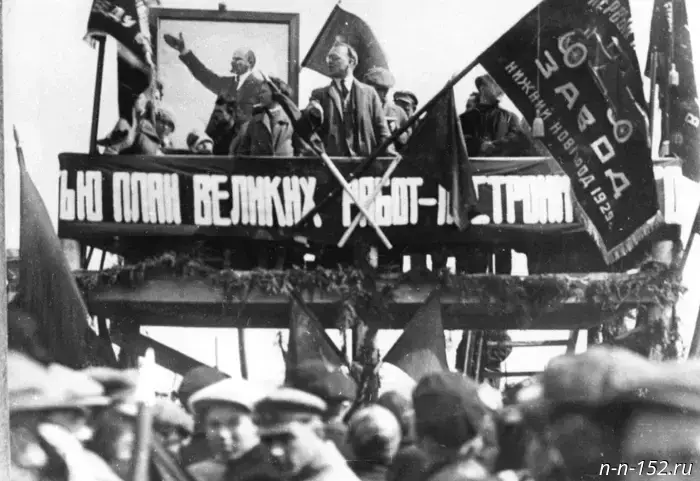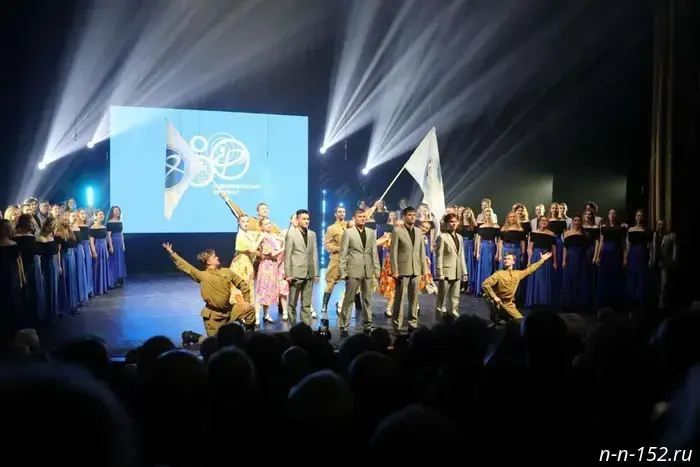
Avtozavodsky District of Nizhny Novgorod: history and archival photographs
Nizhny Novgorod amazes with the variety of its architecture, and each district of the city has its own unique features. Here you can stroll among monuments of wooden architecture, along merchant streets, and see the monumental buildings of the Soviet period. IA “V gorode N” decided to launch a series of materials about the history of the districts of the Volga capital. The first of them is devoted to Avtozavodsky.
Birth of the district
Photo: Village Monastyrka, 1930s / Administration of Nizhny Novgorod
The history of the Avtozavodsky District is, of course, closely linked with the history of GAZ. Before the plant opened, there were several villages and swamps on this site. In May 1930 construction of the automobile plant began here and the first barracks were occupied. To erect the factory buildings, many peasants from various parts of the Nizhny Novgorod region moved in, and thus the Eastern, Western, Northern and American settlements appeared.
Photo: Construction of the Gorky Automobile Plant, 1930 / Administration of Nizhny Novgorod
Photo: GAZ museum (1929–1930)
Because the plant was being built far from other parts of Nizhny Novgorod, in 1931 it was decided to form a separate district here.
Photo: Construction of residential buildings, 1930s / Administration of Nizhny Novgorod
At the same time the first blocks of the Social Town began to be built, where it was planned to embody the ideal of collectivist forms of life. A competition for the design was announced, and the work of students from MVTU won. Already the following year the first foundation stone was laid for a house on Zhdanov Avenue (now Molodezhny Prospect). In addition to living rooms, the building had corners for collective recreation, communal kitchens, toilets and baths. Nearby a club was built with halls for meetings and sports, a canteen, a library, kiosks and a post and telegraph office.
Photo: Nizhny Novgorod: illustrated catalog of monuments of history and culture of federal significance / author collective; ed. A.L. Gelfond // Centralized Library System of the Avtozavodsky District
In the autumn of the next year people began to move into the house. Initially, construction of several more similar buildings was planned, but the project was decided to be revised. As a result, four‑story houses with shared communal and utility rooms began to be erected.
Photo: Nizhny Novgorod: illustrated catalog of monuments of history and culture of federal significance / author collective; ed. A.L. Gelfond // Centralized Library System of the Avtozavodsky District
Residential construction could not keep pace with the development of GAZ, and to accommodate all the plant workers it was decided to build several hundred temporary wooden two‑story houses.
Photo: Barrack‑type residential building, 1934 / Administration of Nizhny Novgorod
Within a year the Avtozavodsky District had a bread factory, and then a bathhouse, a laundry, a factory‑kitchen, a school and shops. There were concrete roads, asphalted sidewalks, and a square with fountains was laid out on Ilyich Prospect. In 1933 the first tram, No. 12, was run along the district, and a month later the bridge across the Oka opened. In those years the unique hotel “Volna” appeared on the city map.
Development of the automobile plant
In 1933 it was decided to expand the plant, which meant new housing was needed for workers. By that time Stalinist Empire style had replaced minimalism in architecture. They began to build houses closed along the perimeter with arches and public spaces on the ground floors. Facades became more “ornamental,” and apartments more comfortable.
Photo: Nizhny Novgorod: illustrated catalog of monuments of history and culture of federal significance / author collective; ed. A.L. Gelfond // Centralized Library System of the Avtozavodsky District
Among the architecture of that period the radial block along Zhdanov Prospect and the Busygin houses stand out, named in honor of the initiator of the Stakhanovite movement at the automobile plant, who lived in one of them.
Photo: Nizhny Novgorod: illustrated catalog of monuments of history and culture of federal significance / author collective; ed. A.L. Gelfond // Centralized Library System of the Avtozavodsky District
In 1937 a department store building and several schools were built, as well as a cinema‑concert hall where the “Mir” cinema is now located. At the end of the 1930s the “Happy” Children’s Railway station appeared at Avtozavod; today that building houses the Marriage Palace.
Photo: Nizhny Novgorod: illustrated catalog of monuments of history and culture of federal significance / author collective; ed. A.L. Gelfond // Centralized Library System of the Avtozavodsky District
In those same years, by the efforts of one and a half thousand Gorky residents, the City Garden was laid out, which Nizhny Novgorod residents now know as the Park of Culture and Leisure, and in 1936 a tram appeared in the Social Town, which by the end of the decade ran to the Gnilitsy settlement. At the same time construction of the airport began.
Photo: Main entrance to the Park of Culture and Leisure / A.V. Shchusev Museum of Architecture // pastvu.com
Wartime
Photo: Centralized Library System of the Avtozavodsky District
Avtozavod suffered greatly during the Great Patriotic War. Nevertheless, work on the creation of the Park of Culture and Leisure continued, which gained a fountain and a wooden Summer Theater that later became the “Rodina” cinema.
Most of the damage during the war was sustained by the plant itself, but the citizens of Gorky managed to restore the plant’s facilities in just 100 days, for which in 1944 the enterprise was awarded the Order of the Red Banner, and a year later the GAZ collective was awarded the Order of the Patriotic War, 1st class, for successfully fulfilling the GKO’s assignments to produce self‑propelled artillery units.
Photo: Kindergarten in the Avtozavodsky District of Gorky after a raid. P.A. Voznesensky / NGIAMZ // GOSCATALOG.RF
Postwar years
Photo: Residential buildings on Ilyich Prospect / Administration of Nizhny Novgorod
The war interrupted large‑scale construction. In the postwar years, to address the housing problem, individual houses were erected using industrial waste and low‑rise buildings. Plant workers began to build housing with their own hands. Thus, by the method of “people’s construction,” the 40 Years of October settlement was created.
In the mid‑century the district’s map saw the appearance of the Torpedo stadium, new hospitals and the Palace of Culture named after the Leninist Komsomol. Tram route No. 17 was laid. The ornate Stalinist Empire gave way to “Khrushchyovkas,” which were bland but could provide housing for a large number of citizens and allow for the clearing of communal apartments.
In the 1960s a dairy plant, a swimming pool and the Avtozavod Palace of Culture were built. By this time trolleybuses could already be seen on the district’s streets. In the 1970s–1980s construction of Social Town II began, the Museum of the History and Labor Glory of the Automobile Plant opened, the Monument to the Glory of the fallen plant workers was erected and a branch of the Gorky Polytechnic Institute opened on Leskova Street, and construction of the metro began.
Modern times
The 1990s were difficult both for the automobile plant and for the district around it. Despite all the hardships the country experienced at that time, the Torpedo Sports Palace and the Pioneer stadium, a shopping center, a meat processing complex were built, and Molodezhny Prospect was reconstructed. Today the Avtozavodsky District continues to develop and be built up, yet it still remains a unique monument to the Soviet dream.
Author: Anya Dolinina
Any use of the materials is permitted only with an active link to vgoroden.ru
Tags: city history, Avtozavodsky district
Add V gorode N to
Found an error? Tell us about it.
Другие Новости Нижнего (Н-Н-152)
 The Nizhny Novgorod stadium will purchase a passenger electric vehicle.
Nizhny Novgorod News
Two women from Nizhny Novgorod fell victim to scammers while buying vouchers for a resort in Abkhazia.
Nizhny Novgorod News
The Nizhny Novgorod stadium will purchase a passenger electric vehicle.
Nizhny Novgorod News
Two women from Nizhny Novgorod fell victim to scammers while buying vouchers for a resort in Abkhazia.
Nizhny Novgorod News
 Writer Zakhar Prilepin plans to return to the SVO zone in November.
Nizhny Novgorod writer Zakhar Prilepin, prematurely discharged from service after being wounded, plans to return to the area of the special military operation in November 2025. October 25, 2025. vGorodeN.Ru. Nizhny Novgorod Region. Nizhny Novgorod.
Writer Zakhar Prilepin plans to return to the SVO zone in November.
Nizhny Novgorod writer Zakhar Prilepin, prematurely discharged from service after being wounded, plans to return to the area of the special military operation in November 2025. October 25, 2025. vGorodeN.Ru. Nizhny Novgorod Region. Nizhny Novgorod.
 The Faculty of Radiophysics at NNSU grandly celebrated its 80th anniversary.
Nizhny Novgorod News
The timetable for commuter trains between Nizhny Novgorod and Mokhovye Gory will change as of November 2.
Nizhny Novgorod News
A businessman was punished over a teenager who was injured by a firecracker in Nizhny Novgorod.
Photo: freepik.com
An entrepreneur was punished for selling pyrotechnics to a minor in Nizhny Novgorod. October 24, 2025. Online publication "Zhivem v Nizhnem". Nizhny Novgorod Oblast. Nizhny Novgorod.
The Faculty of Radiophysics at NNSU grandly celebrated its 80th anniversary.
Nizhny Novgorod News
The timetable for commuter trains between Nizhny Novgorod and Mokhovye Gory will change as of November 2.
Nizhny Novgorod News
A businessman was punished over a teenager who was injured by a firecracker in Nizhny Novgorod.
Photo: freepik.com
An entrepreneur was punished for selling pyrotechnics to a minor in Nizhny Novgorod. October 24, 2025. Online publication "Zhivem v Nizhnem". Nizhny Novgorod Oblast. Nizhny Novgorod.
Avtozavodsky District of Nizhny Novgorod: history and archival photographs
Nizhny Novgorod is striking in the diversity of its architecture, and each district of the city has its own unique characteristics. 25.10.2025. vGorodeN.Ru. Nizhny Novgorod Oblast. Nizhny Novgorod.
